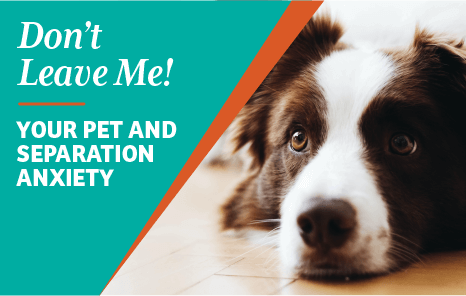
Don’t Leave Me!
Your Pet and Separation Anxiety
We love spending time with our furry friends, and most dogs and cats enjoy that time together too. However, sometimes their attachment to us becomes so intense they develop a disorder called separation anxiety.
It’s more than a little whining when you leave or a bit of mischief while you’re out. It’s a serious condition that primarily impacts dogs. According to this piece on animal companion separation anxiety in The New York Times, 20-40% of dogs exhibit signs of separation disorders. For cats, it’s 13%.
What causes separation anxiety? It can happen when pets are left alone for the first time (think new puppy) or longer periods of time when they are used to being with people all day (think humans no longer working from home). Sometimes a change of ownership, loss of a home or moving from a shelter to a new home can trigger anxiety in pets. The loss of a human or another pet companion or even a change in routine can impact sensitive animal companions.
Anxious pets can do extensive damage to your home and property. They can also act in ways that pose a threat to their own health, so it’s important to recognize the symptoms early on and work proactively to address anxiety before things get out of hand.
The symptoms of separation anxiety in dogs include:
- Urinating and defecating inside
- Howling
- Pacing
- Destructive chewing
- Escaping/running away
A cat shows his anxiety a little differently:
- Excessive meowing, moaning, or crying
- Eliminating outside the litterbox
- Unhealthy levels of self-grooming
- Overeating or not eating at all
- Odd/overly enthusiastic behavior when you return home
What are some tips to help with separation anxiety in pets?
- Practice leaving the house. Leave the house for short periods of time, but don’t go far. If your pet begins to bark, meow, whine, or scratch at the door while you’re away for those few minutes, wait until it’s quiet before going back in. Gradually increase the time you are gone.
- Make leaving a non-event. Don’t acknowledge your pet or say goodbye when you go. Not making a big deal out of leaving will help your pet see separation as no big deal, a regular occurrence.
- Exercise, exercise, exercise. Treat your cat to a long play session or take your dog for a walk, run, or some other energy-burning activity before you leave. This is extremely helpful in reducing stress. A tired pet has a much greater chance of being a calm pet.
- Provide enrichment for your pet. Try interactive games, puzzles, and toys to keep your pet occupied while you’re away. These toys and games don’t have to be expensive to be effective and distracting.
- Leave music or the television on. Find something soothing to keep your pet company in your absence.
Be patient. It can take time for your pet to acclimate to a new routine. Celebrate small triumphs with treats and praise.
Should I give my pet medication?
It’s best to try drug-free approaches to dealing with separation anxiety before resorting to medication. However, some pets are more predisposed to anxiety than others, and, in those cases, medication might be the better choice for soothing anxious animals.
A good place to start is with herbal and pheromone-based solutions, including Adaptil for dogs or Feliway for cats. They are available in collar, spray, and diffuser form and help create a calm environment for your pet. If these products don’t help, prescription medications such as trazodone, fluoxetine, and Sileo have helped many of our patients overcome serious anxiety disorders.
When should I see veterinarian for pet separation anxiety?
Any time your pet is acting in a way that concerns you, especially if he or she is engaging in behavior that might be harmful to his or her own health, contact us at (480) 893-8423 to make an appointment as soon as possible.
